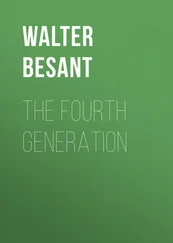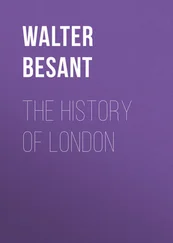Walter Besant - London
Здесь есть возможность читать онлайн «Walter Besant - London» — ознакомительный отрывок электронной книги совершенно бесплатно, а после прочтения отрывка купить полную версию. В некоторых случаях можно слушать аудио, скачать через торрент в формате fb2 и присутствует краткое содержание. Жанр: foreign_antique, foreign_prose, на английском языке. Описание произведения, (предисловие) а так же отзывы посетителей доступны на портале библиотеки ЛибКат.
- Название:London
- Автор:
- Жанр:
- Год:неизвестен
- ISBN:нет данных
- Рейтинг книги:4 / 5. Голосов: 1
-
Избранное:Добавить в избранное
- Отзывы:
-
Ваша оценка:
- 80
- 1
- 2
- 3
- 4
- 5
London: краткое содержание, описание и аннотация
Предлагаем к чтению аннотацию, описание, краткое содержание или предисловие (зависит от того, что написал сам автор книги «London»). Если вы не нашли необходимую информацию о книге — напишите в комментариях, мы постараемся отыскать её.
London — читать онлайн ознакомительный отрывок
Ниже представлен текст книги, разбитый по страницам. Система сохранения места последней прочитанной страницы, позволяет с удобством читать онлайн бесплатно книгу «London», без необходимости каждый раз заново искать на чём Вы остановились. Поставьте закладку, и сможете в любой момент перейти на страницу, на которой закончили чтение.
Интервал:
Закладка:
The Englishman, thus converted, was received into the company of civilized nations. Scholars came across the Channel to teach him Latin, monks came to teach him the life of self-sacrifice, obedience, submission, and abstinence. The monastery reared its humble walls everywhere; the first foundation of the first bishop of London was a monastery. In times of war between the kinglets – when were there no wars? – the monasteries, after the whole country had been converted, were spared. Therefore the people settled around them, and enjoyed their protection. The monastery towns grew rapidly and prospered. New arts were introduced and taught by the monks, new ideas sprang up among the people, new wants were created. Moreover, intercourse began with other nations – the ecclesiastic who journeyed to Rome took with him a goodly troop of priests, monks, and laymen; they saw strange lands and observed strange customs. Some of them learned foreign languages, and even made friendships with the men who spoke them, discovering that a man who speaks another tongue is not necessarily an enemy. The Englishman was changed; yet he remained still, as he always does, whether he creates a new empire in America, or one in Australia, always an Englishman.
Meantime the kinglets made war with each other, and London became a prize for each in turn. It passed from the East Saxon to the Northumbrian, to the Mercian, to the West Saxon, as the hegemony passed from one to the other. Each kinglet learned more and more to recognize its importance and its value. One of the oldest civic documents extant is a grant of King Ethelbald to the Bishop of Rochester. He gives him the right of passing one ship of his own, or of another's, free of toll into the port of London. The toll of incoming and outgoing vessels formed, therefore, part of the royal revenue.
The history of London between A.D. 600 and the Norman Conquest is the history of England. How the City fell into the hands of the Danes, how it was finally secured by Alfred, how the Danes again obtained the City without fighting, and how the Norman was received in peace, belong to history. All this time London was steadily growing. Whatever king sat on the throne, her trade increased, and her wealth.
The buildings, till long after the Norman Conquest, were small and mean: the better houses were timber frames, with shutters or lattices, but no glass for the windows; the poorer houses were of wattle and daub. The churches were numerous and small. Some of them were still of wood, though a few were built of stone, with the simple circular arch. The first church of St. Paul's was destroyed by fire, a fate which awaited the second and the third. By the time of Edward the Confessor the second church was completed; but of this church we have no record whatever. The Saxon period, as concerns London, is the darkest of any. You may see at the Guildhall nearly everything that remains of Roman London. But there is nothing, absolutely not one single stone, to illustrate Saxon London. The city which grew up over the deserted Augusta and flourished for four hundred years has entirely disappeared. Nothing is left of it at all. The chief destroyer of Saxon London was the great fire of 1135, which swept London from end to end as effectually as that of 1666. Had it not been for these two fires, we should very likely have still standing one or two of the sturdy little Saxon churches of which the country yet affords one surviving example. Yet London is not alone in having no monuments of this period. If we take any other town, what remains in it of the years A.D. 600-1000? What is left in Rome to mark the reigns of the eighty Popes who fill that period? What in Paris to illustrate the rule of the Carlovingians? Fire and the piety of successive generations have destroyed all the buildings.
For outside show the city of Edward the Confessor and that of the second Henry were very nearly the same, and so may be treated together. The churches burned down in 1135 were rebuilt in stone, but the houses presented much the same appearance. Now, everybody who speaks of Norman London must needs speak of William Fitz Stephen. He is our only authority; all that we can do is to make commentaries and guesses based on the text of Fitz Stephen.
He was a clerk in the service of Thomas à Becket; he was present at the archbishop's murder; he wrote a Life of the saint, to which he prefixed, by happy inspiration, a brief eulogy of the City of London. It is far too brief, but it contains facts of the most priceless importance. London, we learn, possessed, besides its great cathedral, thirteen large conventual churches and one hundred and twenty-six parish churches. The White Tower was already built on the east side; the walls of the City, now kept in good repair, encircled it on all sides except the river; here the wall which had formerly defended the river front had been taken down to make way for warehouses and quays; the Royal Palace stood without the City, but connected with it by a populous suburb. Those who lived "in the suburbs" – that is, about Chancery Lane and Holborn – had spacious and beautiful gardens; there were also on this side pasture and meadow lands, with streams and water-mills; beyond the pastures was a great forest filled with wild creatures; many springs of water rose on the north side. The City was so populous that of those who went out to a muster, 20,000 were chosen as horsemen and 60,000 for the foot. We will discuss the question of population later on. Meantime one may remark that a force of 80,000 always ready to be called out means a population of 320,000 at least, which is indeed absurd, especially when we consider that the population of London, as shown by the poll-tax of Richard II., was only about 40,000.
There were three principal schools, but sometimes other schools were opened "by favor and permission." We are not told what schools these were; but there was always a school of some kind attached to every monastery and nunnery. The boys were taught Latin verse, grammar, and rhetoric; they disputed with each other in the churches on feast-days, especially about the "principles of grammar, and the rules of the past and future tenses" – truly, an agreeable pastime.
The different trades of the City were allotted their own places of work and sale. Fitz Stephen does not name the various quarters, but they can be easily ascertained from Stow, though the place assigned to each was sometimes changed. Thus, the chief market and trading-place of the City was always Cheap, a broad, open place with booths and sheds for the exposure of wares, on the north and south. The names of the streets leading out of Cheap indicate the trades that were carried on in them. The streets called Wood, Milk, Iron, Honey, Poultry, mark the site of certain markets on the north. Those named after Bread, Candles, Soap, Fish, Money-changing, are shown on the south. Along the rivers were breweries, of which one remains to this day; artificers of various kinds were gathered together in their own streets about the town. This custom of congregation was useful in more ways than one: it gave dignity to the craft and inspired self-respect for the craftsmen, it kept up the standard of good work, it made craftsmen regard each other as brethren, not as enemies; it gave them guilds, of which our trades-unions, which think of nothing but wages, are the degenerate successors; and it brought each trade under the salutary rule of the Church.
There was then – there has always been – a great plenty of food in the city of London; on the river-bank, among the vintners, there were eating-houses where at all times of the day and every day there were cooked and sold meat and fish and every kind of food. Once a week, on Friday, there was a horse-fair in Smithfield without the walls; at this fair there were races every week.
The young men of the City were greatly addicted to sports of all kinds: they skated in winter, they tilted on the water and on land, they fought, wrestled, practised archery, danced, and sang. They were a turbulent, courageous, free and independent youth, proud of their city and its wealth, proud of their power and their freedom, proud of the trade which came to their quays from every part of the world. What says Fitz Stephen?
Читать дальшеИнтервал:
Закладка:
Похожие книги на «London»
Представляем Вашему вниманию похожие книги на «London» списком для выбора. Мы отобрали схожую по названию и смыслу литературу в надежде предоставить читателям больше вариантов отыскать новые, интересные, ещё непрочитанные произведения.
Обсуждение, отзывы о книге «London» и просто собственные мнения читателей. Оставьте ваши комментарии, напишите, что Вы думаете о произведении, его смысле или главных героях. Укажите что конкретно понравилось, а что нет, и почему Вы так считаете.












